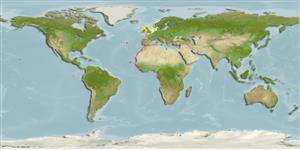>
Blenniiformes (Blennies) >
Blenniidae (Combtooth blennies) > Salariinae
Etymology: Hypleurochilus: Greek, hypo = under + Greek, pleura = in the side of + Greek, cheilos = lip.
More on author: Poll.
Environment: milieu / climate zone / intervalo de profundidade / distribution range
Ecologia
marinhas demersal; intervalo de profundidade 0 - 30 m (Ref. 97251), usually 0 - 5 m (Ref. 97251). Subtropical
Eastern Central Atlantic: Moanda-Tonde and Crique de Banana, Congo. Mediterranean Sea: Off Naples, Palermo, Alger and coast of Israel.
Tamanho / Peso / Idade
Maturidade: Lm ? range ? - ? cm
Max length : 12.0 cm TL macho/indeterminado; (Ref. 97251)
Descrição breve
Chaves de identificação | Morfologia | Morfometria
Diagnosed by having the following characteristics: brown-yellowish body color with five irregular vertical dark bars extending to the lower part of the dorsal fin; remaining part of fin same as body color; head may have some bluish tinge; thick superior upper lip; mark V-like cavity between the eyes; wrinkled dorsal area between the head and the beginning of dorsal fin; caudal fin with a series of alternating light and dark vertical bars; cirri with several branches, grouped in a common base; most developed branch lies at the centre and surrounded by several thinner and shorter branches (Ref. 97253).
Body shape (shape guide): fusiform / normal.
Adults occur in shallow waters near harbors and on rocky shores of coastal waters (Ref. 5298, 5981). Oviparous. Males are extremely territorial especially when guarding eggs (Ref. 97521). Eggs are demersal and adhesive (Ref. 205), and are attached to the substrate via a filamentous, adhesive pad or pedestal (Ref. 94114). Larvae are planktonic, often found in shallow, coastal waters (Ref. 94114).
Life cycle and mating behavior
Maturidade | Reprodução | Desova | Ovos | Fecundidade | Larvas
Oviparous, distinct pairing (Ref. 205).
Bath, H., 1990. Blenniidae. p. 905-915. In J.C. Quero, J.C. Hureau, C. Karrer, A. Post and L. Saldanha (eds.) Check-list of the fishes of the eastern tropical Atlantic (CLOFETA). JNICT, Lisbon; SEI, Paris; and UNESCO, Paris. Vol. 2. (Ref. 5298)
Categoria na Lista Vermelha da IUCN (Ref. 130435: Version 2025-1)
Ameaça para o homem
Harmless
Utilização humana
Ferramentas
Relatórios especiais
Descarregue XML
Fontes da internet
Estimates based on models
Preferred temperature (Ref.
123201): 16 - 27.9, mean 20 °C (based on 593 cells).
Phylogenetic diversity index (Ref.
82804): PD
50 = 0.5005 [Uniqueness, from 0.5 = low to 2.0 = high].
Bayesian length-weight: a=0.01047 (0.00461 - 0.02381), b=2.98 (2.79 - 3.17), in cm total length, based on LWR estimates for this (Sub)family-body shape (Ref.
93245).
Nível Trófico (Ref.
69278): 3.2 ±0.3 se; based on size and trophs of closest relatives
Resiliência (Ref.
120179): Elevada, tempo mínimo de duplicação da população menor que 15 meses (Preliminary K or Fecundity.).
Fishing Vulnerability (Ref.
59153): Low vulnerability (10 of 100).
🛈
